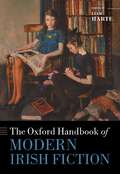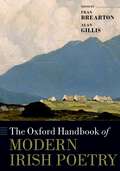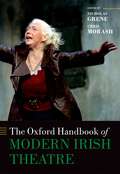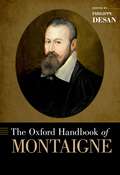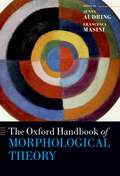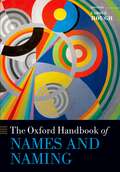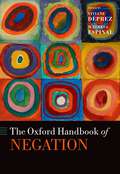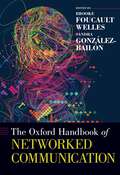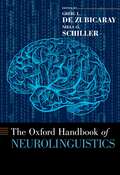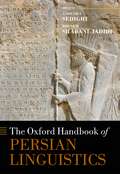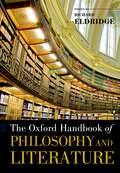- Table View
- List View
The Oxford Handbook of Modern Indian Literatures (Oxford Handbooks)
The Oxford Handbook of Modern Indian Literatures refutes the Anglocentrism of much literary criticism of the global South by examining "Indian Literature" as a multilingual, dialogic, and plural space constituted by both continuities and divergences. In forty-three chapters and with a team of scholars who exemplify the method of historically situated and theoretically rigorous literary criticism, this volume shows how the idea of Indian literature is a relational and comparative concept. Through readings of a vast diversity of multilingual literature in a range of genres, the chapters highlight contact zones and interchanges across seemingly sedimented boundaries. The Handbook provides an overview of the current state of modern Indian writing and features a range of texts and approaches from across India's many languages and literary traditions, examining and amplifying recent critical attention to the multilingualism that is at the base of any curation of what could be termed, with qualification, "Indian Literatures." The book ranges from the 19th century to the 21st, with especial focus on the centrality of gender and caste to Indian modernism and new generic formations such as graphic novels, autofiction, and videogames.
The Oxford Handbook of Modern Irish Fiction (Oxford Handbooks)
by Liam HarteThe Oxford Handbook of Modern Irish Fiction presents authoritative essays by thirty-five leading scholars of Irish fiction. They provide in-depth assessments of the breadth and achievement of novelists and short story writers whose collective contribution to the evolution and modification of these unique art forms has been far out of proportion to Ireland's small size. The volume brings a variety of critical perspectives to bear on the development of modern Irish fiction, situating authors, texts, and genres in their social, intellectual, and literary historical contexts. The Handbook's coverage encompasses an expansive range of topics, including the recalcitrant atavisms of Irish Gothic fiction; nineteenth-century Irish women's fiction and its influence on emergent modernism and cultural nationalism; the diverse modes of irony, fabulism, and social realism that characterize the fiction of the Irish Literary Revival; the fearless aesthetic radicalism of James Joyce; the jolting narratological experiments of Samuel Beckett, Flann O'Brien, and Máirtín Ó Cadhain; the fate of the realist and modernist traditions in the work of Elizabeth Bowen, Frank O'Connor, Seán O'Faoláin, and Mary Lavin, and in that of their ambivalent heirs, Edna O'Brien, John McGahern, and John Banville; the subversive treatment of sexuality and gender in Northern Irish women's fiction written during and after the Troubles; the often neglected genres of Irish crime fiction, science fiction, and fiction for children; the many-hued novelistic responses to the experiences of famine, revolution, and emigration; and the variety and vibrancy of post-millennial fiction from both parts of Ireland. Readably written and employing a wealth of original research, The Oxford Handbook of Modern Irish Fiction illuminates a distinguished literary tradition that has altered the shape of world literature.
The Oxford Handbook of Modern Irish Fiction (Oxford Handbooks)
The Oxford Handbook of Modern Irish Fiction presents authoritative essays by thirty-five leading scholars of Irish fiction. They provide in-depth assessments of the breadth and achievement of novelists and short story writers whose collective contribution to the evolution and modification of these unique art forms has been far out of proportion to Ireland's small size. The volume brings a variety of critical perspectives to bear on the development of modern Irish fiction, situating authors, texts, and genres in their social, intellectual, and literary historical contexts. The Handbook's coverage encompasses an expansive range of topics, including the recalcitrant atavisms of Irish Gothic fiction; nineteenth-century Irish women's fiction and its influence on emergent modernism and cultural nationalism; the diverse modes of irony, fabulism, and social realism that characterize the fiction of the Irish Literary Revival; the fearless aesthetic radicalism of James Joyce; the jolting narratological experiments of Samuel Beckett, Flann O'Brien, and Máirtín Ó Cadhain; the fate of the realist and modernist traditions in the work of Elizabeth Bowen, Frank O'Connor, Seán O'Faoláin, and Mary Lavin, and in that of their ambivalent heirs, Edna O'Brien, John McGahern, and John Banville; the subversive treatment of sexuality and gender in Northern Irish women's fiction written during and after the Troubles; the often neglected genres of Irish crime fiction, science fiction, and fiction for children; the many-hued novelistic responses to the experiences of famine, revolution, and emigration; and the variety and vibrancy of post-millennial fiction from both parts of Ireland. Readably written and employing a wealth of original research, The Oxford Handbook of Modern Irish Fiction illuminates a distinguished literary tradition that has altered the shape of world literature.
The Oxford Handbook of Modern Irish Poetry (Oxford Handbooks)
Forty chapters, written by leading scholars across the world, describe the latest thinking on modern Irish poetry. The Handbook begins with a consideration of Yeats's early work, and the legacy of the 19th century. The broadly chronological areas which follow, covering the period from the 1910s through to the 21st century, allow scope for coverage of key poetic voices in Ireland in their historical and political context. From the experimentalism of Beckett, MacGreevy, and others of the modernist generation, to the refashioning of Yeats's Ireland on the part of poets such as MacNeice, Kavanagh, and Clarke mid-century, through to the controversially titled post-1969 'Northern Renaissance' of poetry, this volume will provide extensive coverage of the key movements of the modern period. The Handbook covers the work of, among others, Paul Durcan, Thomas Kinsella, Brendan Kennelly, Seamus Heaney, Paul Muldoon, Michael Longley, Medbh McGuckian, and Ciaran Carson. The thematic sections interspersed throughout - chapters on women's poetry, religion, translation, painting, music, stylistics - allow for comparative studies of poets north and south across the century. Central to the guiding spirit of this project is the Handbook's consideration of poetic forms, and a number of essays explore the generic diversity of poetry in Ireland, its various manipulations, reinventions and sometimes repudiations of traditional forms. The last essays in the book examine the work of a 'new' generation of poets from Ireland, concentrating on work published in the last two decades by Justin Quinn, Leontia Flynn, Sinead Morrissey, David Wheatley, Vona Groarke, and others.
The Oxford Handbook of Modern Irish Theatre (Oxford Handbooks)
by Nicholas Grene and Chris MorashThe Oxford Handbook of Modern Irish Theatre provides the single most comprehensive survey of the field to be found in a single volume. Drawing on more than forty contributors from around the world, the book addresses a full range of topics relating to modern Irish theatre from the late nineteenth-century to the most recent works of postdramatic devised theatre. Ireland has long had an importance in the world of theatre out of all proportion to the size of the country, and has been home to four Nobel Laureates (Yeats, Shaw, and Beckett; Seamus Heaney, while primarily a poet, also wrote for the stage). This collection begins with the influence of melodrama, and looks at arguably the first modern Irish playwright, Oscar Wilde, before moving into a series of considerations of the Abbey Theatre, and Irish modernism. Arranged chronologically, it explores areas such as women in theatre, Irish-language theatre, and alternative theatres, before reaching the major writers of more recent Irish theatre, including Brian Friel and Tom Murphy, and their successors. There are also individual chapters focusing on Beckett and Shaw, as well as a series of chapters looking at design, acting, and theatre architecture. The book concludes with an extended survey of the critical literature on the field. In each chapter, the author does not simply rehearse accepted wisdom; all of the contributors push the boundaries of their respective fields, so that each chapter is a significant contribution to scholarship in its own right.
The Oxford Handbook of Monsters in Classical Myth (Oxford Handbooks)
The Oxford Handbook of Monsters in Classical Myth presents forty chapters about the unique and terrifying creatures from myths of the long-ago Near East and Mediterranean world, featuring authoritative contributions by many of the top international experts on ancient monsters and the monstrous. The first part provides original studies of individual monsters such as the Chimaera, Cerberus, the Hydra, and the Minotaur, and of monster groups such as dragons, centaurs, sirens, and Cyclopes. This section also explores their encounters with the major heroes of classical myth, including Perseus, Jason, Heracles, and Odysseus. The second part examines monsters of ancient folklore and ethnography, encompassing the restless dead, blood-drinking lamiae, exotic hybrid animals, the so-called dog-headed men, and many other unexpected creatures and peoples. The third part covers various interpretations of these creatures from multiple perspectives, including psychoanalysis, colonialism, and disability studies, with monster theory itself evident across the entire volume. The final part discusses reception of these ancient monsters across time and space--from the Middle Ages to the Renaissance to modern times, from Persia to Scandinavia, the Caribbean, and Latin America-and concludes with chapters considering the use and adaptation of ancient monsters in children's literature, science fiction, fantasy, and modern scientific disciplines. This Handbook is the first large-scale, inclusive guide to monsters in antiquity, their places in literature and art across the millennia, and their influence on later literature and thought.
The Oxford Handbook of Montaigne (Oxford Handbooks)
by Philippe DesanIn 1580, Michel de Montaigne (1533-1592) published a book unique by its title and its content: Essays"R. A literary genre was born. At first sight, the Essays resemble a patchwork of personal reflections, but they engage with questions that animate the human mind, and tend toward a single goal: to live better in the present and to prepare for death. For this reason, Montaigne's thought and writings have been a subject of enduring interest across disciplines. This Handbook brings together essays by prominent scholars that examine Montaigne's literary, philosophical, and political contributions, and assess his legacy and relevance today in a global perspective. The chapters of this Handbook offer a sweeping study of Montaigne across different disciplines and in a global perspective. One section covers the historical Montaigne, situating his thought in his own time and space, notably the Wars of Religion in France. The political, historical and religious context of Montaigne's Essays requires a rigorous presentation to inform the modern reader of the issues and problems that confronted Montaigne and his contemporaries in his own time. In addition to this contextual approach to Montaigne, the Handbook also establishes a connection between Montaigne's writings and issues and problems directly relevant to our modern times, that is to say, our age of global ideology. Montaigne's considerations, or essays, offer a point of departure for the modern reader's own assessments. The Essays analyze what can be broadly defined as human nature, the endless process by which the individual tries to impose opinions upon others through the production of laws, policies or philosophies. Montaigne's motto -- "What do I know?" -- is a simple question yet one of perennial significance. One could argue that reading Montaigne today teaches us that the angle defines the world we see, or, as Montaigne wrote: "What matters is not merely that we see the thing, but how we see it."
The Oxford Handbook of Montaigne (Oxford Handbooks)
In 1580, Michel de Montaigne (1533-1592) published a book unique by its title and its content: Essays"R. A literary genre was born. At first sight, the Essays resemble a patchwork of personal reflections, but they engage with questions that animate the human mind, and tend toward a single goal: to live better in the present and to prepare for death. For this reason, Montaigne's thought and writings have been a subject of enduring interest across disciplines. This Handbook brings together essays by prominent scholars that examine Montaigne's literary, philosophical, and political contributions, and assess his legacy and relevance today in a global perspective. The chapters of this Handbook offer a sweeping study of Montaigne across different disciplines and in a global perspective. One section covers the historical Montaigne, situating his thought in his own time and space, notably the Wars of Religion in France. The political, historical and religious context of Montaigne's Essays requires a rigorous presentation to inform the modern reader of the issues and problems that confronted Montaigne and his contemporaries in his own time. In addition to this contextual approach to Montaigne, the Handbook also establishes a connection between Montaigne's writings and issues and problems directly relevant to our modern times, that is to say, our age of global ideology. Montaigne's considerations, or essays, offer a point of departure for the modern reader's own assessments. The Essays analyze what can be broadly defined as human nature, the endless process by which the individual tries to impose opinions upon others through the production of laws, policies or philosophies. Montaigne's motto -- "What do I know?" -- is a simple question yet one of perennial significance. One could argue that reading Montaigne today teaches us that the angle defines the world we see, or, as Montaigne wrote: "What matters is not merely that we see the thing, but how we see it."
The Oxford Handbook of Morphological Theory (Oxford Handbooks)
by Jenny Audring Francesca MasiniThis volume is the first handbook devoted entirely to the multitude of frameworks adopted in the field of morphology, including Minimalism, Optimality Theory, Network Morphology, Cognitive Grammar, and Canonical Typology. Following an introduction from the editors, the first part of the volume offers critical discussions of the main theoretical issues within morphology, both in word formation and in inflection, as well as providing a short history of morphological theory. In the core part of the handbook, part II, each theory is introduced by an expert in the field, who guides the reader through its principles and technicalities, its advantages and disadvantages, and its points of agreement and disagreement with alternative theories. Chapters in part III explore the bigger picture, connecting morphological theory to other subdisciplines of linguistics, such as diachronic change, language acquisition, psycholinguistics, and sign language theory. The handbook is intended as a guide for morphologists from all theoretical backgrounds who want to learn more about frameworks other than their own, as well as for linguists in related subfields looking for theoretical connections with the field of morphology.
The Oxford Handbook of Morphological Theory
This volume is the first handbook devoted entirely to the multitude of frameworks adopted in the field of morphology, including Minimalism, Optimality Theory, Network Morphology, Cognitive Grammar, and Canonical Typology. Following an introduction from the editors, the first part of the volume offers critical discussions of the main theoretical issues within morphology, both in word formation and in inflection, as well as providing a short history of morphological theory. In the core part of the handbook, part II, each theory is introduced by an expert in the field, who guides the reader through its principles and technicalities, its advantages and disadvantages, and its points of agreement and disagreement with alternative theories. Chapters in part III explore the bigger picture, connecting morphological theory to other subdisciplines of linguistics, such as diachronic change, language acquisition, psycholinguistics, and sign language theory. The handbook is intended as a guide for morphologists from all theoretical backgrounds who want to learn more about frameworks other than their own, as well as for linguists in related subfields looking for theoretical connections with the field of morphology.
The Oxford Handbook of Names and Naming (Oxford Handbooks)
by Carole Hough and Daria IzdebskaIn this handbook, scholars from around the world offer an up-to-date account of the state of the art in different areas of onomastics, in a format that is both useful to specialists in related fields and accessible to the general reader. Since Ancient Greece, names have been regarded as central to the study of language, and this has continued to be a major theme of both philosophical and linguistic enquiry throughout the history of Western thought. The investigation of name origins is more recent, as is the study of names in literature. Relatively new is the study of names in society, which draws on techniques from sociolinguistics and has gradually been gathering momentum over the last few decades. The structure of this volume reflects the emergence of the main branches of name studies, in roughly chronological order. The first Part focuses on name theory and outlines key issues about the role of names in language, focusing on grammar, meaning, and discourse. Parts II and III deal with the study of place-names and personal names respectively, while Part IV outlines contrasting approaches to the study of names in literature, with case studies from different languages and time periods. Part V explores the field of socio-onomastics, with chapters relating to the names of people, places, and commercial products. Part VI then examines the interdisciplinary nature of name studies, before the concluding Part presents a selection of animate and inanimate referents ranging from aircraft to animals, and explains the naming strategies adopted for them.
The Oxford Handbook of Names and Naming (Oxford Handbooks)
In this handbook, scholars from around the world offer an up-to-date account of the state of the art in different areas of onomastics, in a format that is both useful to specialists in related fields and accessible to the general reader. Since Ancient Greece, names have been regarded as central to the study of language, and this has continued to be a major theme of both philosophical and linguistic enquiry throughout the history of Western thought. The investigation of name origins is more recent, as is the study of names in literature. Relatively new is the study of names in society, which draws on techniques from sociolinguistics and has gradually been gathering momentum over the last few decades. The structure of this volume reflects the emergence of the main branches of name studies, in roughly chronological order. The first Part focuses on name theory and outlines key issues about the role of names in language, focusing on grammar, meaning, and discourse. Parts II and III deal with the study of place-names and personal names respectively, while Part IV outlines contrasting approaches to the study of names in literature, with case studies from different languages and time periods. Part V explores the field of socio-onomastics, with chapters relating to the names of people, places, and commercial products. Part VI then examines the interdisciplinary nature of name studies, before the concluding Part presents a selection of animate and inanimate referents ranging from aircraft to animals, and explains the naming strategies adopted for them.
The Oxford Handbook of Negation (Oxford Handbooks)
by Viviane Déprez M. Teresa EspinalIn this volume, international experts in negation provide a comprehensive overview of cross-linguistic and philosophical research in the field, as well as accounts of more recent results from experimental linguistics, psycholinguistics, and neuroscience. The volume adopts an interdisciplinary approach to a range of fundamental questions ranging from why negation displays so many distinct linguistic forms to how prosody and gesture participate in the interpretation of negative utterances. Following an introduction from the editors, the chapters are arranged in eight parts that explore, respectively, the fundamentals of negation; issues in syntax; the syntax-semantics interface; semantics and pragmatics; negative dependencies; synchronic and diachronic variation; the emergence and acquisition of negation; and experimental investigations of negation. The volume will be an essential reference for students and researchers across a wide range of disciplines, and will facilitate further interdisciplinary work in the field.
The Oxford Handbook of Negation (Oxford Handbooks)
In this volume, international experts in negation provide a comprehensive overview of cross-linguistic and philosophical research in the field, as well as accounts of more recent results from experimental linguistics, psycholinguistics, and neuroscience. The volume adopts an interdisciplinary approach to a range of fundamental questions ranging from why negation displays so many distinct linguistic forms to how prosody and gesture participate in the interpretation of negative utterances. Following an introduction from the editors, the chapters are arranged in eight parts that explore, respectively, the fundamentals of negation; issues in syntax; the syntax-semantics interface; semantics and pragmatics; negative dependencies; synchronic and diachronic variation; the emergence and acquisition of negation; and experimental investigations of negation. The volume will be an essential reference for students and researchers across a wide range of disciplines, and will facilitate further interdisciplinary work in the field.
The Oxford Handbook of Neo-Latin (Oxford Handbooks)
by Sarah Knight and Stefan TilgFrom the dawn of the early modern period around 1400 until the eighteenth century, Latin was still the European language and its influence extended as far as Asia and the Americas. At the same time, the production of Latin writing exploded thanks to book printing and new literary and cultural dynamics. Latin also entered into a complex interplay with the rising vernacular languages. This Handbook gives an accessible survey of the main genres, contexts, and regions of Neo-Latin, as we have come to call Latin writing composed in the wake of Petrarch (1304-74). Its emphasis is on the period of Neo-Latin's greatest cultural relevance, from the fifteenth to the eighteenth centuries. Its chapters, written by specialists in the field, present individual methodologies and focuses while retaining an introductory character. The Handbook will be valuable to all readers wanting to orientate themselves in the immense ocean of Neo-Latin literature and culture. It will be particularly helpful for those working on early modern languages and literatures as well as to classicists working on the culture of ancient Rome, its early modern reception and the shifting characteristics of post-classical Latin language and literature. Political, social, cultural and intellectual historians will find much relevant material in the Handbook, and it will provide a rich range of material to scholars researching the history of their respective geographical areas of interest.
The Oxford Handbook of Neo-Latin (Oxford Handbooks)
From the dawn of the early modern period around 1400 until the eighteenth century, Latin was still the European language and its influence extended as far as Asia and the Americas. At the same time, the production of Latin writing exploded thanks to book printing and new literary and cultural dynamics. Latin also entered into a complex interplay with the rising vernacular languages. This Handbook gives an accessible survey of the main genres, contexts, and regions of Neo-Latin, as we have come to call Latin writing composed in the wake of Petrarch (1304-74). Its emphasis is on the period of Neo-Latin's greatest cultural relevance, from the fifteenth to the eighteenth centuries. Its chapters, written by specialists in the field, present individual methodologies and focuses while retaining an introductory character. The Handbook will be valuable to all readers wanting to orientate themselves in the immense ocean of Neo-Latin literature and culture. It will be particularly helpful for those working on early modern languages and literatures as well as to classicists working on the culture of ancient Rome, its early modern reception and the shifting characteristics of post-classical Latin language and literature. Political, social, cultural and intellectual historians will find much relevant material in the Handbook, and it will provide a rich range of material to scholars researching the history of their respective geographical areas of interest.
The Oxford Handbook of Networked Communication (Oxford Handbooks)
by Brooke Foucault Welles Sandra González-BailónCommunication technologies, including the internet, social media, and countless online applications create the infrastructure and interface through which many of our interactions take place today. This form of networked communication creates new questions about how we establish relationships, engage in public, build a sense of identity, and delimit the private domain. The ubiquitous adoption of new technologies has also produced, as a byproduct, new ways of observing the world: many of our interactions now leave a digital trail that, if followed, can help us unravel the rhythms of social life and the complexity of the world we inhabit--and thus help us reconstruct the logic of social order and change. The analysis of digital data requires partnerships across disciplinary boundaries that--although on the rise--are still uncommon. Social scientists and computer scientists have never been closer in their goals of trying to understand communication dynamics, but there are not many venues where they can engage in an open exchange of methods and theoretical insights. This handbook brings together scholars across the social and technological sciences to lay the foundations of communication research in the networked age, and to provide a canon of how research should be conducted in the digital era. The contributors highlight the main theories currently guiding their research in digital communication, and discuss state-of-the-art methodological tools, including automated text analysis, the analysis of networks, and the use of natural experiments in virtual environments. Following a general introduction, the handbook covers network and information flow, communication and organizational dynamics, interactions and social capital, mobility and space, political communication and behavior, and the ethics of digital research.
The Oxford Handbook of Networked Communication (Oxford Handbooks)
Communication technologies, including the internet, social media, and countless online applications create the infrastructure and interface through which many of our interactions take place today. This form of networked communication creates new questions about how we establish relationships, engage in public, build a sense of identity, and delimit the private domain. The ubiquitous adoption of new technologies has also produced, as a byproduct, new ways of observing the world: many of our interactions now leave a digital trail that, if followed, can help us unravel the rhythms of social life and the complexity of the world we inhabit--and thus help us reconstruct the logic of social order and change. The analysis of digital data requires partnerships across disciplinary boundaries that--although on the rise--are still uncommon. Social scientists and computer scientists have never been closer in their goals of trying to understand communication dynamics, but there are not many venues where they can engage in an open exchange of methods and theoretical insights. This handbook brings together scholars across the social and technological sciences to lay the foundations of communication research in the networked age, and to provide a canon of how research should be conducted in the digital era. The contributors highlight the main theories currently guiding their research in digital communication, and discuss state-of-the-art methodological tools, including automated text analysis, the analysis of networks, and the use of natural experiments in virtual environments. Following a general introduction, the handbook covers network and information flow, communication and organizational dynamics, interactions and social capital, mobility and space, political communication and behavior, and the ethics of digital research.
The Oxford Handbook of Neurolinguistics (Oxford Handbooks)
by GREIG I. DE ZUBICARAY Niels O. SchillerNeurolinguistics is a young and highly interdisciplinary field, with influences from psycholinguistics, psychology, aphasiology, and (cognitive) neuroscience, as well as other fields. Neurolinguistics, like psycholinguistics, covers aspects of language processing; but unlike psycholinguistics, it draws on data from patients with damage to language processing capacities, or the use of modern neuroimaging technologies such as fMRI, TMS, or both. The burgeoning interest in neurolinguistics reflects that an understanding of the neural bases of this data can inform more biologically plausible models of the human capacity for language. The Oxford Handbook of Neurolinguistics provides concise overviews of this rapidly-growing field, and engages a broad audience with an interest in the neurobiology of language. The chapters do not attempt to provide exhaustive coverage, but rather present discussions of prominent questions posed by given topics. The volume opens with essential methodological chapters: Section I, Methods, covers the key techniques and technologies used to study the neurobiology of language today, with chapters structured along the basic divisions of the field. Section II addresses the neurobiology of language acquisition during healthy development and in response to challenges presented by congenital and acquired conditions. Section III covers the many facets of our articulate brain, or speech-language pathology, and the capacity for language production-written, spoken, and signed. Questions regarding how the brain comprehends meaning, including emotions at word and discourse levels, are addressed in Section IV. Finally, Section V reaches into broader territory, characterizing and contextualizing the neurobiology of language with respect to more fundamental neuroanatomical mechanisms and general cognitive domains.
The Oxford Handbook of Neurolinguistics (Oxford Handbooks)
Neurolinguistics is a young and highly interdisciplinary field, with influences from psycholinguistics, psychology, aphasiology, and (cognitive) neuroscience, as well as other fields. Neurolinguistics, like psycholinguistics, covers aspects of language processing; but unlike psycholinguistics, it draws on data from patients with damage to language processing capacities, or the use of modern neuroimaging technologies such as fMRI, TMS, or both. The burgeoning interest in neurolinguistics reflects that an understanding of the neural bases of this data can inform more biologically plausible models of the human capacity for language. The Oxford Handbook of Neurolinguistics provides concise overviews of this rapidly-growing field, and engages a broad audience with an interest in the neurobiology of language. The chapters do not attempt to provide exhaustive coverage, but rather present discussions of prominent questions posed by given topics. The volume opens with essential methodological chapters: Section I, Methods, covers the key techniques and technologies used to study the neurobiology of language today, with chapters structured along the basic divisions of the field. Section II addresses the neurobiology of language acquisition during healthy development and in response to challenges presented by congenital and acquired conditions. Section III covers the many facets of our articulate brain, or speech-language pathology, and the capacity for language production-written, spoken, and signed. Questions regarding how the brain comprehends meaning, including emotions at word and discourse levels, are addressed in Section IV. Finally, Section V reaches into broader territory, characterizing and contextualizing the neurobiology of language with respect to more fundamental neuroanatomical mechanisms and general cognitive domains.
The Oxford Handbook of Oral History (Oxford Handbooks)
by Donald A. RitchieIn the past sixty years, oral history has moved from the periphery to the mainstream of academic studies and is now employed as a research tool by historians, anthropologists, sociologists, medical therapists, documentary film makers, and educators at all levels. The Oxford Handbook of Oral History brings together forty authors on five continents to address the evolution of oral history, the impact of digital technology, the most recent methodological and archival issues, and the application of oral history to both scholarly research and public presentations. The volume is addressed to seasoned practitioners as well as to newcomers, offering diverse perspectives on the current state of the field and its likely future developments. Some of its chapters survey large areas of oral history research and examine how they developed; others offer case studies that deal with specific projects, issues, and applications of oral history. From the Holocaust, the South African Truth and Reconciliation Commissions, the Falklands War in Argentina, the Velvet Revolution in Eastern Europe, to memories of September 11, 2001 and of Hurricane Katrina, the creative and essential efforts of oral historians worldwide are examined and explained in this multipurpose handbook.
The Oxford Handbook of Oral History (Oxford Handbooks)
In the past sixty years, oral history has moved from the periphery to the mainstream of academic studies and is now employed as a research tool by historians, anthropologists, sociologists, medical therapists, documentary film makers, and educators at all levels. The Oxford Handbook of Oral History brings together forty authors on five continents to address the evolution of oral history, the impact of digital technology, the most recent methodological and archival issues, and the application of oral history to both scholarly research and public presentations. The volume is addressed to seasoned practitioners as well as to newcomers, offering diverse perspectives on the current state of the field and its likely future developments. Some of its chapters survey large areas of oral history research and examine how they developed; others offer case studies that deal with specific projects, issues, and applications of oral history. From the Holocaust, the South African Truth and Reconciliation Commissions, the Falklands War in Argentina, the Velvet Revolution in Eastern Europe, to memories of September 11, 2001 and of Hurricane Katrina, the creative and essential efforts of oral historians worldwide are examined and explained in this multipurpose handbook.
The Oxford Handbook of Persian Linguistics (Oxford Handbooks)
by Pouneh Shabani-Jadidi Anousha SedighiThis handbook offers a comprehensive overview of the field of Persian linguistics, discusses its development, and captures critical accounts of cutting edge research within its major subfields, as well as outlining current debates and suggesting productive lines of future research. Leading scholars in the major subfields of Persian linguistics examine a range of topics split into six thematic parts. Following a detailed introduction from the editors, the volume begins by placing Persian in its historical and typological context in Part I. Chapters in Part II examine topics relating to phonetics and phonology, while Part III looks at approaches to and features of Persian syntax. The fourth part of the volume explores morphology and lexicography, as well as the work of the Academy of Persian Language and Literature. Part V, language and people, covers topics such as language contact and teaching Persian as a foreign language, while the final part examines psycho- neuro-, and computational linguistics. The volume will be an essential resource for all scholars with an interest in Persian language and linguistics.
The Oxford Handbook of Persian Linguistics (Oxford Handbooks)
This handbook offers a comprehensive overview of the field of Persian linguistics, discusses its development, and captures critical accounts of cutting edge research within its major subfields, as well as outlining current debates and suggesting productive lines of future research. Leading scholars in the major subfields of Persian linguistics examine a range of topics split into six thematic parts. Following a detailed introduction from the editors, the volume begins by placing Persian in its historical and typological context in Part I. Chapters in Part II examine topics relating to phonetics and phonology, while Part III looks at approaches to and features of Persian syntax. The fourth part of the volume explores morphology and lexicography, as well as the work of the Academy of Persian Language and Literature. Part V, language and people, covers topics such as language contact and teaching Persian as a foreign language, while the final part examines psycho- neuro-, and computational linguistics. The volume will be an essential resource for all scholars with an interest in Persian language and linguistics.
The Oxford Handbook of Philosophy and Literature (Oxford Handbooks)
The Oxford Handbook of Philosophy and Literature contains twenty-three newly commissioned essays by major philosophers and literary scholars that investigate literature as a form of attention to human life. Various forms of attention are considered under the headings of Genres (from Ancient Epic to the Novel and Contemporary Experimental Writing), Periods (from Realism and Romanticism to Postcolonialism), Devices and Powers (Imagination, Plot, Character, Style, and Emotion), and Contexts and Uses (in relation to inquiry, morality, and politics). In each case, the effort is to track and evaluate how specific modes and works of imaginative literature answer to important needs of human subjects for orientation, the articulation of interest in life, and the working through of emotion, within situations that are both sociohistorical and human. Hence these essays show how and why literature matters in manifold ways in and for human cultural life, and they show how philosophers and imaginative literary writers have continually both engaged with and criticized each other.

